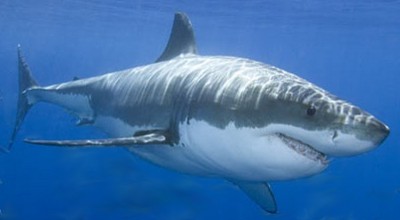Great White Shark
Category: Shark

Facts about Great White Sharks, "Scientific name for Great White Shark is Carcharodon carcharias". Great White Shark is the world’s largest predatory fish, growing in lengths sometimes exceeding 19 feet (5.79 meters), and weighs approximately 5,000 lbs (2270 kg) and can be heavier.
The Great White Sharks mouth contains up to 3000 individual sharp serrated teeth separated in rows, and when one breaks off another takes its place. The teeth can measure more than 2 1/2 inches (5.7 centimeters) long.
This species of lamniform shark can be found in any warm coastal and offshore waters, including the United States, the Mediterranean, Japan, Chile, and South Africa, where population seem to be the densest.
An adult Great White Sharks can swim up to a speed of 43 miles (69 kilometers) per hour. And is known to leap out of the water from below to catch their prey.
Like all sharks, the Great White is a cartilaginous fish, which means that their skeletons are made of cartilage, not bone. The Great White Shark are also related to rays are; scientists list them together in a group called elasmobranches, a sub class of cartilaginous fish.
The Great White Shark exploded into popular culture and world-wide fear, with the release of Peter Benchley’s best–seller “Jaws†, and the 1975 release of the Steven Spielberg Blockbuster movie of the same name. This is what gave the status of being man-eaters, which is actually far from the truth.
While the Great White Shark has attacked humans, they are not there intentional target and its role as a menace is exaggerated.
The Great White Sharks main diet is the protein-rich seal and squid, sea lions, fish, and even other sharks. The Great White Shark have taste buds inside their throats and mouths that lets them know what the food is before swallowing it.
Great White Shark do not attack humans on purpose, sometime they mistake a human for a fresh meal and take a bite until they recognize its not their normal diet. But this has still not stopped the Great White Shark from putting fear in hearts of many people.
Great White Sharks have two small openings above and behind the eyes. Their ears are small, but they are very powerful. Inside their ears, there are cells that can sense in the surrounding water even the tiniest vibration.
Great white sharks have an elaborate sense of touch, what’s called the lateral line – a visible line along the side of a Great white shark’s body and all other fish, from its to its head to its tail, consisting of a series of sense organs that detect vibration and pressure, its made of cells that can recognize vibrations in the water. Great white sharks can detect both the amount of movement and the direction made by its prey, even from as far as 800 feet (244 meters) away.
There are over 400 types of sharks, Sharks have the most powerful jaws on on earth. Great White Sharks jaws, both the upper and lower jaws move. Great White Sharks skin is made of denticles instead of scales like other fish. The denticles are constructed like hard, sharp teeth (tooth-like projection) and this helps to protect the Great White Shark from being injury. The Great White Shark is carnivores, meaning: an animal that feeds on flesh (Meat). "Scientific name for Shark Selachimorpha"
"Fear of Sharks Selachophobia".

 Back To Category Shark
Back To Category Shark